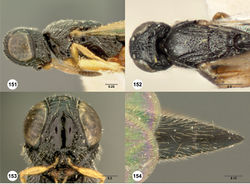Oxyscelio cupularis
| Notice: | This page is derived from the original publication listed below, whose author(s) should always be credited. Further contributors may edit and improve the content of this page and, consequently, need to be credited as well (see page history). Any assessment of factual correctness requires a careful review of the original article as well as of subsequent contributions.
If you are uncertain whether your planned contribution is correct or not, we suggest that you use the associated discussion page instead of editing the page directly. This page should be cited as follows (rationale):
Citation formats to copy and paste
BibTeX: @article{Burks2013ZooKeys292, RIS/ Endnote: TY - JOUR Wikipedia/ Citizendium: <ref name="Burks2013ZooKeys292">{{Citation See also the citation download page at the journal. |
Ordo: Hymenoptera
Familia: Platygastridae
Genus: Oxyscelio
Name
Oxyscelio cupularis (Kieffer) – Wikispecies link – ZooBank link – Pensoft Profile
- Camptoteleia cupularis Kieffer, 1914: 296, 298 (original description, keyed); Kieffer 1916[1]: 171 (keyed); Kieffer 1926[2]: 380, 384 (description, keyed).
- Oxyscelio cupularis (Kieffer): Dodd 1931[3]: 75 (generic transfer).
Description
Female. Body length 5.15–5.3 mm (n=2).
Radicle color: same color as scape. Scape color: Yellowish. A4: longer than broad. A5: longer than broad. Antennal club: formed, segments compact.
Interantennal process: not elongate. Median longitudinal elevation in frontal depression: absent. Frontal depression: concave. Frontal depression sculpture: with 2 oblique interrupted carinae. Submedian carina: strong, formed by a sharp raised carina. Submedian carina medially: with sharp peak. Concavity across dorsal part of frontal depression: absent. Depression extending ventrally from median ocellus: absent. Upper frons: not hood-like. Malar area near antennal foramen: with oblique tooth-like flange (facial nubbin). Malar area at mouth corner: without striae. Smooth strip along posterior side of malar sulcus: present, broad throughout its length. Middle genal carina: absent. Direction of middle genal carina dorsally: parallel to eye margin. Major sculpture of gena anteriorly: umbilicate-foveate. Major sculpture of gena posteriorly: umbilicate-foveate; rugose. Microsculpture of gena anteroventrally: absent. Microsculpture of gena posteroventrally: absent. Median carina extending posteriorly from hyperoccipital carina: absent. Hyperoccipital carina: not indicated medially. Lateral connection between hyperoccipital and occipital carinae: absent. Area between vertex and occipital carina: umbilicate-foveate. Occipital carina medially: sinuate, concave medial to corners, but without a median peak. Lateral corners of occipital carina: sharp and protruding.
Lateral pronotal area: without bulge projecting towards anterior pit. Epomial corner: strong. Netrion surface anteriorly: not inflexed. Mesoscutum anteriorly: not steep. Mesoscutal median carina: present and complete. Longitudinal carina between median carina and notauli: absent. Major sculpture of medial mesoscutum anteriorly: umbilicate-foveate. Major sculpture of medial mesoscutum posteriorly: umbilicate-foveate. Microsculpture of medial mesoscutum anteriorly: granulate. Microsculpture of medial mesoscutum posteriorly: absent. Major sculpture of mesoscutellum: umbilicate-foveate. Microsculpture of mesoscutellum medially: absent. Microsculpture of mesoscutellum laterally: granulate. Mesoscutellar apex: convex or straight. Setae along anterior limit of femoral depression: arising from rows of foveae. Number of carinae crossing speculum above femoral depression: 2. Number of carinae crossing femoral depression: 3-5. Mesepimeral sulcus pits: more than 5. Metascutellum dorsally: concave. Metascutellar sculpture dorsally: smooth or with transverse carinae. Median carina of metascutellum: absent or branched. Metascutellar setae: absent. Metascutellar apex: convex or straight; weakly emarginate. Metapleuron above ventral metapleural area: crossed by carinae. Metasomal depression setae: absent. Lateral propodeal carinae anteromedially: strongly diverging. Anterior areoles of metasomal depression: absent. Anterior longitudinal carinae in metasomal depression: absent. Lateral propodeal areas: separated medially. Postmarginal vein: present. Fore wing apex: reaching apex of T4.
T1 midlobe: obscured by other raised sculpture. T1: with small rounded anterior bulge, not reaching metascutellum. T2: with straight longitudinal striae or rugae. T6: longer than broad. Apical flange of T6: not exposed apically. Metasomal apex: rounded. Major sculpture of T6: umbilicate-punctate; longitudinally striate or rugose. Microsculpture of T6: granulate.
Male. Unknown.
Diagnosis
Female: Antennal club formed. A4, A5 longer than broad. Face with oblique expanded flange between antennal foramen and eye. Metascutellum tiny, subrectangular.
Link to distribution map
[http://hol.osu.edu/map-full.html?id=5014]
Material examined
Neotype, female: PHILIPPINES: Laguna Prov., Mount Makiling (Maquiling), no date, Baker, OSUC 268223 (deposited in USNM). Other material: PHILIPPINES: 1 female, OSUC 268259 (USNM).
Comments
The type material of Camptoteleia cupularis Kieffer, collected from Mount Makling, Luzon, in the Philippines, could not be found after an extensive search of collections known to house Kieffer type material. The neotype of Camptoteleia cupularis is presently designated to clarify the taxonomic status of the species. It was selected because of its collection locality and because it agrees with Kieffer’s (1914)[4] description in having a long metasoma, poorly sculptured and shiny mesoscutum, and cupuliform metascutellum.
Taxon Treatment
- Burks, R; Masner, L; Johnson, N; Austin, A; 2013: Systematics of the parasitic wasp genus Oxyscelio Kieffer (Hymenoptera, Platygastridae s.l.), Part I: Indo-Malayan and Palearctic fauna ZooKeys, 292: 1-263. doi
Other References
- ↑ Kieffer J (1916) Neue Scelioniden aus den Philippinen-Inseln. Broteria 14: 58–187.134
- ↑ Kieffer J (1926) Scelionidae. Das Tierreich. Vol. 48. Walter de Gruyter & Co., Berlin, 885 pp.135
- ↑ Dodd A (1931) The genus Oxyscelio Kieffer, its synonymy and species, with a description of one new genus (Hymenoptera: Proctotrypoidea). Proceedings of the Royal Society of Queensland 42: 71–81.121
- ↑ Kieffer J (1914) Enumeration des Serphides (Proctotrupides) des Iles Philippines avec description de genres nouveaux et d’especes nouvelles. Philippine Journal of Science (D) 9: 285–311.133
Images
|
